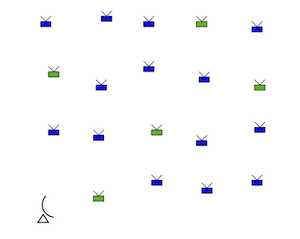 A Wireless Sensor
Network is a set of large number of sensors and a base station. Sensors are small-sized and
low-powered devices deployed over a geographical area. The base station is where data from the
sensors are gathered. Nodes communicate to each other by means of their neighbours. Thus, in
order to reach the base station, sensors send the information to their neighbours and
so on. Therefore, a communication tree is established between the sensors and the base
station.
A Wireless Sensor
Network is a set of large number of sensors and a base station. Sensors are small-sized and
low-powered devices deployed over a geographical area. The base station is where data from the
sensors are gathered. Nodes communicate to each other by means of their neighbours. Thus, in
order to reach the base station, sensors send the information to their neighbours and
so on. Therefore, a communication tree is established between the sensors and the base
station.
A basic task is the systematic gathering at the base station of the sensed data, generally for successive further processing. However, this involves some difficulties:
- Sensor nodes have low-power radio transceivers using batteries to operate.
- Data transmitted by a sensor reach only the nodes within the transmitted range of the sender.
- Nodes far from the base station must use intermediate nodes to relay data transmissions.
- Data collisions may occur. It happens when two or more sensors send data to a common neighbor at the same time.
One of the main goals is to develop algorithms to gather all the messages to the base station in an efficient way: with low power consuption, no interference and in a short time.
I started working on this problem during my PhD thesis and I am still working on it. If you are interested in my publications related to this topic, you can check out my PhD thesis or the publications below. You can find the complete list of my publications related to this topic in my CV.
Further Reading
- Gathering radio messages in the path. Jean-Claude Bermond, Ralf Klasing, Nelson Morales, Stéphane Pérennes, and Patricio Reyes. Discrete Mathematics, Algorithms and Applications, 5(1), Mar. 2013. (A preliminary version can be found here).
- Congestion in Randomly Deployed Wireless Networks. A. Silva, P. Reyes, M. Debbah. Congestion in Randomly Deployed Wireless Ad-Hoc and Sensor Networks. In International Conference on Ultra Modern Telecommunication 2009 (ICUMT09). St Petersburg. October, 2009.

